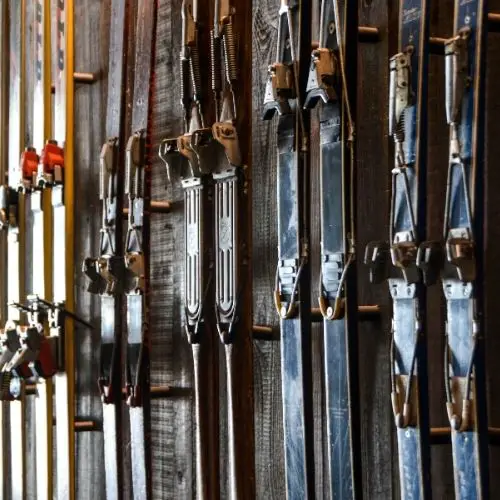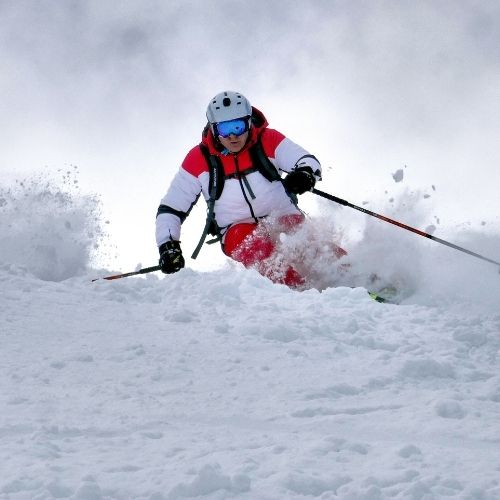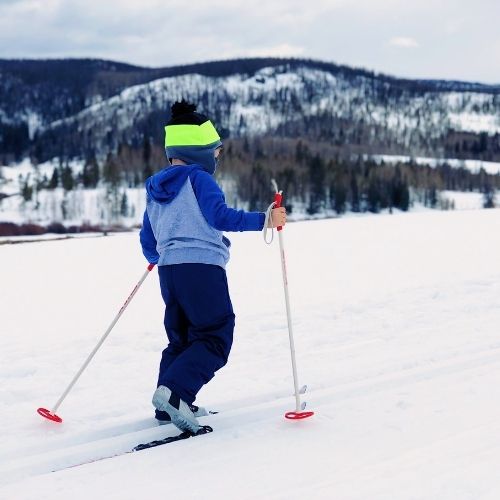We may get commissions for purchases made through links in this post. Thanks for the support! 👍
There is a tool for every job, and when it is no different when it comes to buying a pair of skis. Depending on what type of skiing you like to do and the snow conditions, there are many different kinds of skis that work best for that situation. In this post, we will go through the different kinds of skis to help you decide which ones you need to buy.
When it comes to choosing the right skis, there are several factors you need to think about—namely, your style, the typical snow conditions, and your ability. Depending one which of these you choose, you will be looking to buy skis ranging from carving skis all the way to cross-country skis!

1. Skis For Beginners
There is no such thing as “beginner skis,” but it is best to use skis that are more flexible and shorter in length when starting out. They should also be more forgiving, much easier to turn, and not as fast in a straight line.
Skis for beginners will have a narrow waist. This is the narrowest part of the ski, near to where your bindings are mounted. Narrow waists make it easier to turn the ski.
It is best to use skis that are more flexible and shorter in length when starting out.
Another thing to consider when choosing skis as a beginner is the rocker. This is how much the ski turns up at each end. A ski that has a substantial rocker will be a much better choice for a beginner. This is because it will make it easier to turn at slower speeds. So, when you are looking at the rocker of skis as a beginner, look for ones that have tip and tail rockers.
Skis that are suitable for beginners have a short to medium turn radius until your skills improve.
To Summarize, look for these things:
- Flexible
- Shorter
- Narrow waist
- More substantial rocker
2. Carving skis
These types of skis are primarily designed for groomed runs. Carving skis have a parabolic shape, making them easy to turn and hold and edge.
Some Carving skis are softer and more forgiving, which is ideal for intermediate skiers. Higher-end Carving skis will be stiffer and built to hold an edge even when the snow is very firm.
3. All-Mountain Skis
All-mountain skis are designed to go anywhere. Their shape is similar to carving skis, but they are generally wider, especially underfoot. The extra width allows them to float better when you ski in powder.
You will find many different kinds of all-mountain skis, varying in their stiffness and shape. Some all-mountain skis have a similar shape to carving skis while others take more of a freeride ski shape, including a ‘rockered’ tip that further helps float in powder.
4. Freeride Skis
Freeride skis are a bit like powder skis, but they are not as wide. The primary use of freeride skis is to ride powder in the backcountry. However, they are perfectly capable when skiing groomers.
You will notice that free ride skis are wider than all-mountain skis, and more often than not, they will have a tip rocker. This tip rocker helps keep the ski floating in changeable snow conditions and makes turning on groomed snow easier.
5. Powder Skis
Powder skis are incredibly fat and long to keep you on top of the deepest powder. They generally have a softer flex pattern, which is another thing that improves their performance in deep snow.

Most use a rocker camber or even a reverse camber profile to make them easy to ride in powder. You may come across some specialist powder skis that have a reverse sidecut, similar to water skis.
6. Touring Skis
Touring skis are designed to access the backcountry and places the ski lifts can’t. Touring skis are lightweight and are fitted with bindings that hinge when you are in touring mode but lock back down for the descent.
To make sure you can climb hills in the snow, you fit what are known as skins to the base of your skis. These are furry and stop you from sliding backward but allow you to slide forwards. Skins go in your backpack when it is time to ski back down.
Manufacturers usually have their own line of touring skis, but many skiers are now mounting touring bindings to their free ride skis. This means that they can ski all types of terrain without having to buy multiple pairs of skis.
7. Race Skis
Race skis have a similar shape to carving skis, but they are much stiffer, so they can cope with high speeds and high pressure on the edges. There are different types of race skis too. For example, slalom skis are relatively short, flexible, and responsive. This means that they turn exceptionally quickly, but they are not very versatile.
Giant slalom skis are stiffer than slalom skis. They are also longer with a long sidecut radius. GS skis will be used mainly on hard-packed snow at high speed, as they offer lots of stability and hold an edge very well. If you are not a racer, you will find that race skis are not very forgiving and hard work.
8. Freestyle Skis
Freestyle skis are used by skiers that like to spend time in the park. These skis are very soft and forgiving to make landings as easy as possible. They take their characteristics from freestyle snowboards, as they are usually twin tip.
This means they are symmetrical with turned-up tips and tails, making it easier to land switch (backward). Some freestyle skis can be used as all-mountain skis, but some don’t work well outside of the park at all.
9. Telemark Skis
Telemark skiers are a rare bunch, probably because this is a physically challenging discipline of skiing. To turn, a telemarker slides one ski forward, bending deeply at the knees and arching both skis into the turn.
This is made possible by the hinged bindings. If you want to give this a go, it is best to start out with a set of forgiving skis that turn easily. Most telemarkers will use free ride skis with telemark bindings.
10. Cross-country skis
Cross-country skis are incredibly light and narrow. This design is to make it as easy as possible to push yourself along on varied terrain. Cross-country bindings are hinged to allow you to lift your heel, so you can to stride forwards.

These take some getting used to as a beginner, as they are so thin. But they give you a great workout and allow you to see the mountains in a whole new way.
Other Gear
Skis are obviously one of the biggest components to having a ton of fun in the snow, however you also shouldn’t forget the rest of your gear.
Things like helmets, goggles, and skiing poles are also things you should be keeping in mind.
Conclusion
There are exceptions to every rule, and the lines between some types are blurred by some manufacturers and models.
However, this list of the different kinds of skis will give you a good start in finding the right pair for you.